Key words
Avian Influenza virus, Newcastle Disease Virus, Rapid antigen detection kit, Poultry, Bangladesh
Introduction
Of all the viral diseases, the highly pathogenic avian influenza (HPAI) and Newcastle disease (ND) are considered as top ranking viral diseases of poultry by the Office International des Epizooties [1]. Influenza virus that infects birds is called Avian Influenza Virus (AIV). ND is a deadly endemic disease caused by Newcastle Disease Virus (NDV), also called Avian Paramyxovirus type-1 (APMV-1). Both Avian Influenza (AI) and Newcastle Disease (ND) are zoonotic viral diseases of birds. Influenza also has caused severe losses throughout the century [2]. Both the viral diseases are responsible for serious economic losses every year to the poultry industry all over the world [1].
Avian influenza (AI), bird flu, a highly infectious and emerging viral disease both for the poultry and human now a days, caused by any subtype (H1-16N1-9) of type A influenza virus (AVI) [3]. This is a single stranded RNA, negative sense, enveloped, genome, segmented (8 segments) and encodes with ten different proteins, belongs to the family Orthomyxoviridae [4, 5]. Type A influenza virus infects a wide range of animals such as swine, horses, sea mammals, a large number of birds and human as well [6]. Avian flu can easily spread from domestic birds to other species of birds, but there are human cases also. World Health Organization (WHO: https:// nieman.harvard.edu/Microsites/NiemanGuideToCoveringPandemicFlu/ TheScience/AvianFluBasics.aspx) confirmed 442 cases of H5N1 in humans in Azerbaijan, Bangladesh, Cambodia, China, Djibouti, Egypt, Indonesia, Iraq, Lao people’s Democratic Republic, Myanmar, Nigeria, Pakistan, Thailand, Turkey and Vietnam, leading to 262 deaths, as up to 24 September, 2009 [3]. In Bangladesh in 2007-2008, the chicken population was 212.5 million and duck 39.8 million [7]. In Bangladesh aspect, poultry mainly used as source of income and employment, source of protein food, various industrial uses, use in research work [8]. Recently Bangladesh is facing a serious problem with a series of avian influenza outbreak and resulted massive culling of millions of poultry and poultry products lead to severe economic losses to the owner of more than 500 poultry farms. Until March 2010, AI has reported a total of 326 outbreaks in 49 districts out of 64 districts in Bangladesh (the Ministry of Fisheries and Livestock, Government of Bangladesh). Since first report of outbreak in 2003, the H5N1 in poultry reached epidemic proportion with reports of serious outbreaks in several Asian countries including Vietnam, Thailand, South Korea, Laos, Cambodia, Indonesia, Japan and Malaysia etc. [10, 11]. AI have the ability to affect different species of birds and mammal and the antigenic drift occur within the same strain of type A virus after a series of point mutation of amino acids at the distal region of HA. Existence of the H5N1 was first reported among poultry population of Bangladesh on 21, March 2007 after the catastrophic outbreak of HPAI at Biman poultry Complex, Savar, Dhaka, Bangladesh. The Armed Forces Medical Research Institute (AFRIM) of Thailand first confirmed presence of this subtype (H5N1) of the AIV type A in this country [9].
Newcastle disease (ND) is another highly contagious viral disease of many domestic and wild species of birds throughout the world [12] which is caused by an enveloped, single stranded, negative sense and non-segmented genomic ribonucleic acid (ssRNA) virus of Paramyxoviridae family. Newcastle disease viruses (NDV’s) have three pathotypes: lentogenic, mesogenic, and velogenic. In the context of Bangladesh, ND of poultry is caused mostly by velogenic strains of NDV rather than mesogenic or lentogenic [8]. The rate of mortality in young and adult chickens due to very virulent (vvNDV) varies from 80-100% respectively [13]. NDV affects the respiratory, nervous, and digestive systems. Symptoms are very variable depending on the strain of virus, species of bird, concurrent disease and preexisting immunity. The incubation period for the disease ranges from 2 to 15 days. An infected bird may exhibit the signs of respiratory problems including sneezing, gasping for air, nasal discharge, coughing, greenish, watery diarrhea, nervousness, depression, muscular tremors, drooping wings, twisting of head and neck, circling, complete paralysis and swelling of the tissues around the eyes and in the neck. NDV is so virulent that many birds die without showing any clinical signs. To date there is no known treatment for ND.
Both AI and ND of poultry often manifest similar clinical signs and post-mortem lesions and also appear either single or concurrent infection [14]. Until now, isolation and identification of the AIV and NDV from faeces, various internal organs, oro-nasal and cloacal swabs are considered as the standard method for the diagnosis of both the diseases. Although several diagnostic methods/tests have been designed for the confirmatory diagnosis of AI and ND but primary diagnosis is still preferably made by virus isolation through inoculation of field samples into avian embryos and cell culture, such cultures are followed by demonstration of viruses in the allantoic fluid (AF) and infectious cell culture fluid (ICF) by HA, Hemagglutination inhibition (HI), agar-gel immunodiffusion (AGID) or other antigen-detection methods [15]. The conventional methods such as clinical signs and post-mortem lesions of diagnosis are being practices in Bangladesh for the diagnosis of AI and ND both in the sick and dead birds. However, these techniques have been reported to be of less diagnostic value as such these diagnostic tests may have lots of limitation for confirmatory detection of both AIV and NDV either from field and laboratory samples as well [10]. Considering the above facts in the field of viral disease diagnosis particularly for AIV and NDV in the poultry population of Bangladesh, the present research work was aimed to determine the prevalence of both AIV and NDV in different species of poultry (Layer, Broiler, Native chicken and Duck) in the selected area using an immuno-chromatographic kit as rapid diagnostic tool for the detection and differentiation of AIV from NDV in poultry.
Materials and Methods
Collection of AIV/NDV suspected sample
The cloacal swabs samples were collected from randomly selected ten birds from each of the four different species (layer, broiler, native birds and duck) (Table 1) from four selected areas or districts namely Dhaka (Savar), Mymensingh (Sadar), Gazipur (Sadar) and Bogra (Sadar) in Bangladesh (Figure 1) during the period from September 2010 to March 2011. From four selected districts, a total of 160 cloacal swabs were collected (Table 1). These four districts were selected since major poultry industries are located in these areas. All the samples were collected aseptically in separate sterile plastic vial and kept in ice carrier and then tested in the lab immediately.
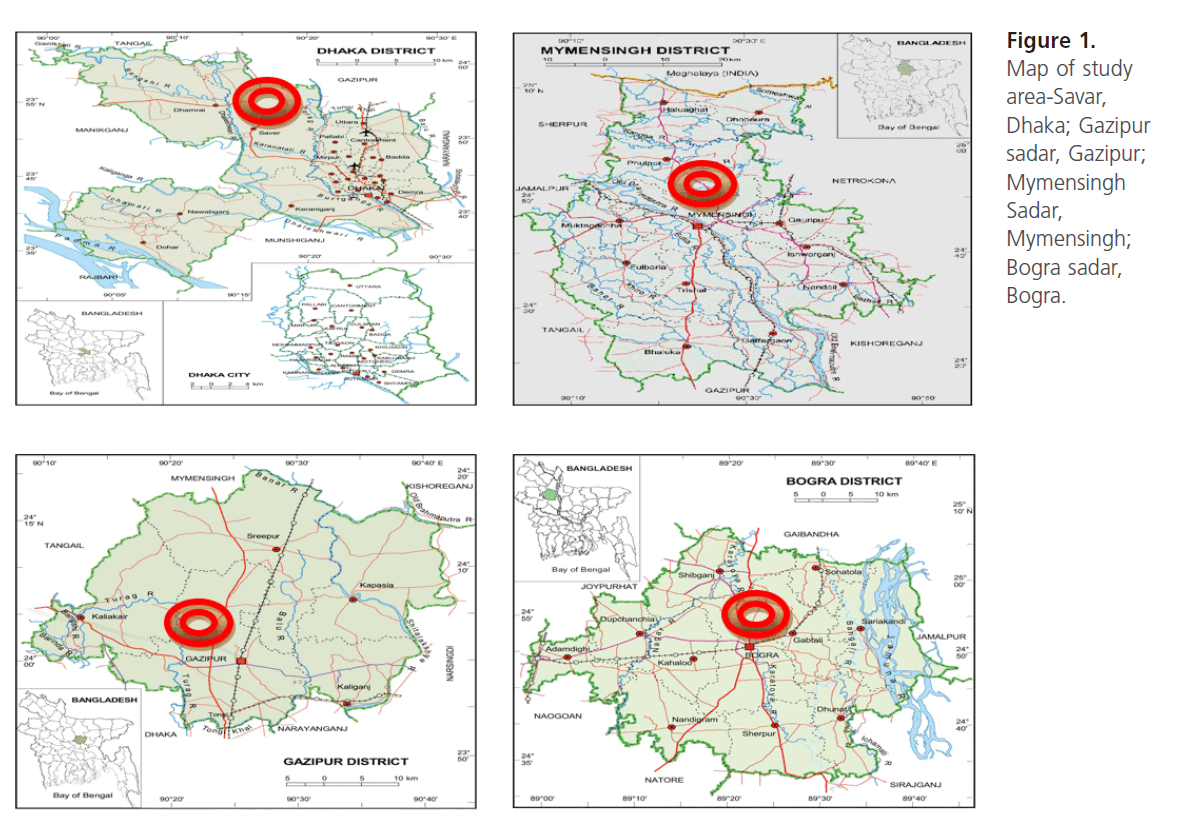
Figure 1: Map of study area-Savar, Dhaka; Gazipur sadar, Gazipur; Mymensingh Sadar, Mymensingh; Bogra sadar,Bogra.
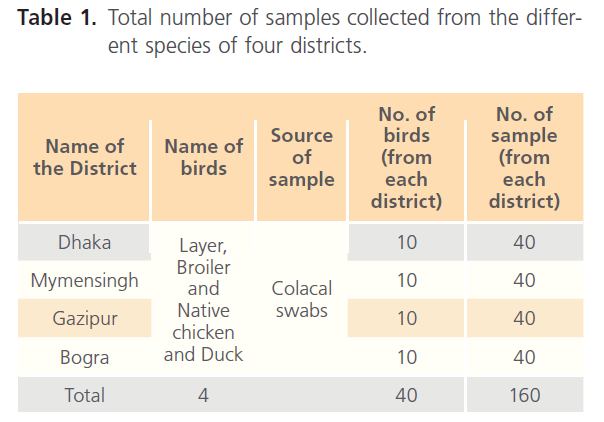
Table 1: Total number of samples collected from the different species of four districts.
Test of AIV-NDV Rapid Ag kit
After collection of samples the test were performed with the help of AIV-NDV rapid Ag test kit (NDV Antigen Rapid Test, AIV Antigen Rapid Test, AIV+NDV Antigen Combo Rapid Test, RapiGEN, South Korea). The test was performed according to the manufacturer’s instructions. Results of the test were observed within 3-5 minutes, recorded naked eye detection of single band for negative control, double band for AIV (H5N1) or NDV positive and triple band both for AIV (H5N1) and NDV positive (Figure 2). Since these kits were tested by the manufacturing company, the efficiency of these kits was not tested but positive and negative control was included in this study.
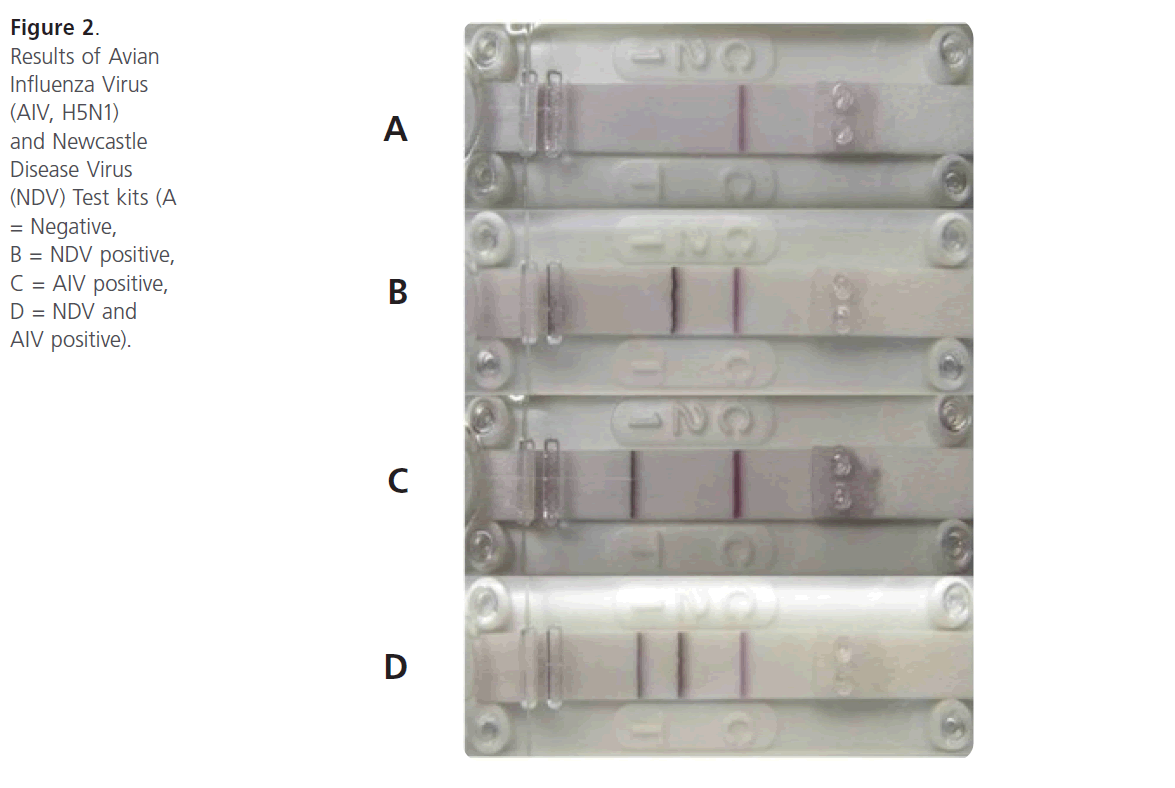
Figure 2: Results of Avian Influenza Virus (AIV, H5N1) and Newcastle Disease Virus (NDV) Test kits (A = Negative, B = NDV positive, C = AIV positive, D = NDV and AIV positive).
Statistical analysis
The results were statistically analyzed for interpretation by using Chi-square tests (χ2). A probability associated with the observed values of chi-square was determined from relevant tables. Significance was determined at 1% and 5% level.
Results
Screening of AIV/NDV in different avian species
A total of 40 samples were collected from the cloacal swab of layer birds from the wet market of four districts. The samples were tested for the presence of AIV or NDV. Among the 40 samples, 10 samples were collected from each of four districts. The samples were tested from Dhaka, Gazipur and Bogra district, AIV was found positive 30.0%, 20.0% and 10.0%, respectively. On the other hand in Mymensingh district, AIV was found negative. In Dhaka, Gazipur, Mymensingh and Bogra district, NDV was found positive 50.0%, 40.0%, 30.0% and 30.0%, respectively (Table 2, Figure 2). In this study, there were a significant relationship of AIV and NDV in layer birds of different districts (p<0.01).
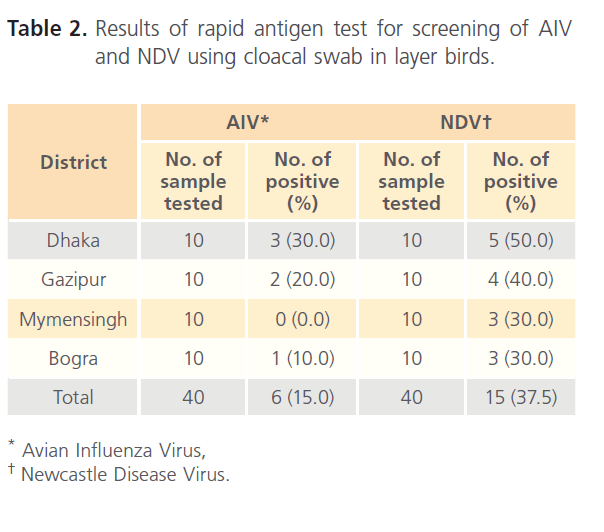
Table 2: Results of rapid antigen test for screening of AIV and NDV using cloacal swab in layer birds.
A total of 40 samples were collected from the cloacal swab of broiler birds from the wet market of four districts. The samples were tested for the presence of AIV or NDV. The samples were tested from Dhaka and Gazipur district, and AIV was found positive 20.0% and 30.0%, respectively. On the other hand in Mymensingh and Bogra district, AIV was found negative. In Dhaka, Gazipur, Mymensingh and Bogra district NDV was found positive in 40.0%, 50.0%, 20.0% and 20.0% cases, respectively (Table 3).

Table 3: Results of rapid antigen test for screening of AIV and NDV using cloacal swab in broiler birds.
A total of 40 samples were collected from the cloacal swab of native birds from the wet market of four districts. The samples were tested for the presence of AIV or NDV. The samples were tested from Dhaka, Gazipur, Mymensingh and Bogra district, and AIV was found negative. In Dhaka, Gazipur, Mymensingh and Bogra district, NDV was found positive 60.0%, 50.0%, 50.0% and 60.0%, respectively (Table 4).
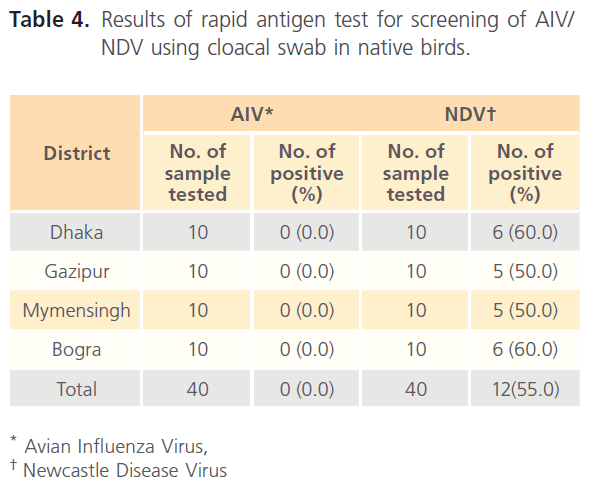
Table 4: Results of rapid antigen test for screening of AIV/ NDV using cloacal swab in native birds.
A total of 40 samples were collected from the cloacal swab of ducks from the wet market of four districts. The samples were tested from Dhaka, Gazipur and Bogra district, and IV was found negative. In Dhaka, Gazipur and Bogra district, NDV was found positive 50.0%, 40.0% and 20.0%, respectively. On the other hand, samples from Mymensingh district were negative for both AIV and NDV (Table 5).
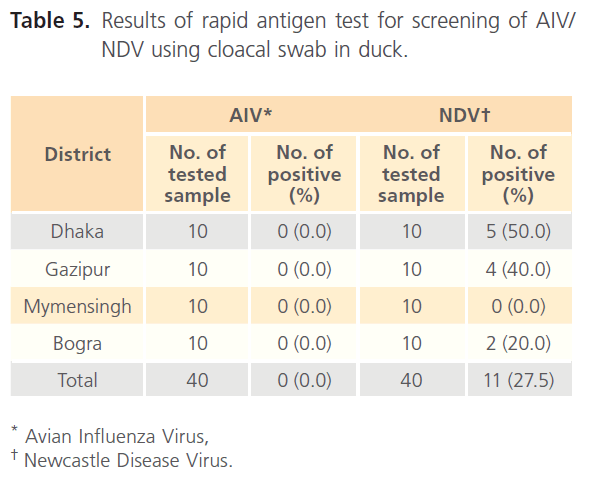
Table 5: Results of rapid antigen test for screening of AIV/ NDV using cloacal swab in duck.
Prevalence of concurrent infection of AIV and NDV in same birds of different species
The prevalence of concurrent infection of AIV and NDV in same birds of different species is shown in Table 6. Considering AIV disease, the result shown that the higher prevalence was in layer (15.0%) than that of other species of birds. On the other hand for NDV, native bird had higher experience of NDV (55.0%) and that was higher in case of other species of birds. In this study there are significant association of prevalence of AIV and NDV in same birds of different species (p<0.01).
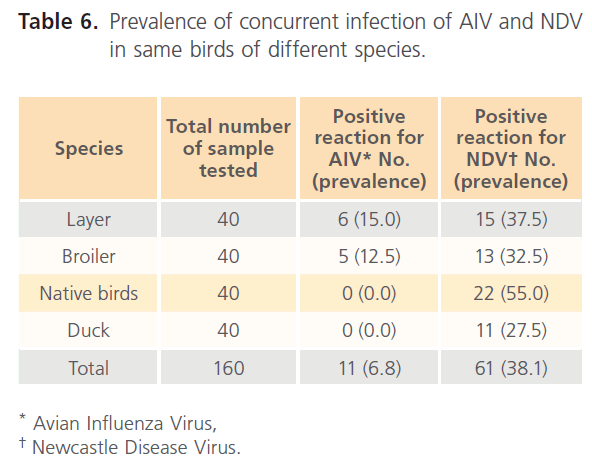
Table 6: Prevalence of concurrent infection of AIV and NDV in same birds of different species.
Prevalence of concurrent infection of AIV and NDV in different districts
The comparison of prevalence rate of AIV and NDV in different district is shown in Table 7. For AIV, the higher prevalence was (12.5%) in Dhaka and Gazipur district and lowest was in Mymensingh (0.0%). In this study there are significant association of prevalence of AIV and NDV in different districts of Bangladesh (p<0.01).
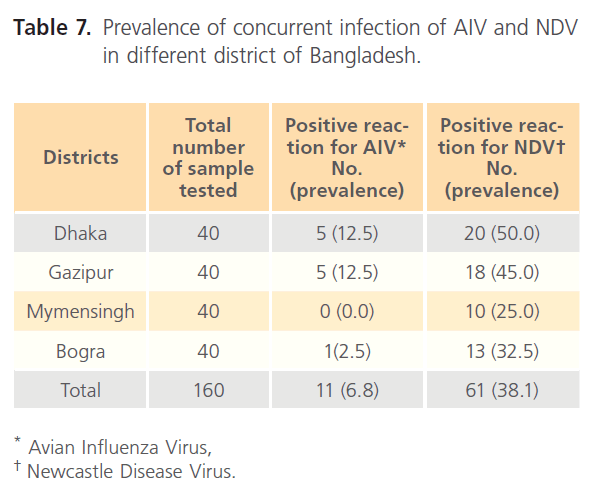
Table 7: Prevalence of concurrent infection of AIV and NDV in different district of Bangladesh.
Overall prevalence of AIV and NDV
The overall prevalence of AIV and NDV showed that out of 160 cloacal samples, positive cases were 11 (6.8%) and 61 (38.1%) for AIV and NDV, respectively. In this study there are no significant association was detected between overall prevalence of AIV and NDV in different species of birds. The result of prevalence of AIV and NDV according to taxonomic order is shown in Table 8. In case of AIV, higher prevalence was observed in galliformes species (9.2%) than that of anseriformes species (0.0%). In the case of NDV, prevalence was 41.7% and 27.5% in galliformes and anseriformes, respectively. In this study there was a significant association between prevalence of AIV and NDV in galliformes (p<0.05) but no significant difference among different species of birds could be detected.
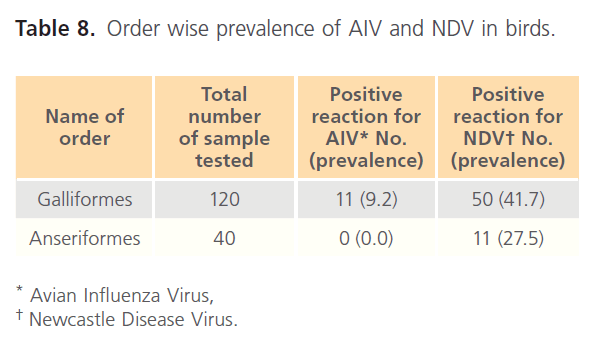
Table 8: Order wise prevalence of AIV and NDV in birds.
Discussion
The research work was carried out to determine the prevalence of Avian Influenza Virus (AIV) type A and Newcastle Disease Virus (NDV) in different species of birds from four districts of Bangladesh. In this study the cloacal swabs were collected from wet market and the test was performed using AIV and NDV rapid Ag test Kit. Results of the test were recorded by observing the single band for negative control, double band for AIV or NDV positive, triple band positive for both AIV and NDV cases within 3-5 minutes. It was observed that the layer birds of wet market of Dhaka, Gazipur and Bogra were positive for both AIV and NDV which might be due to mass gathering of different type of birds since these the major poultry industries are located in these areas in Bangladesh. Additionally, the transportation might be an important cause of spreading of both types of viruses in these areas. In the study it was also observed that the prevalence of AIV in layer birds from the wet market sample was 15.0%. It is comparable with the finding of Negovetich et al [16], who reported 23% prevalence of AIV in live bird market. It was also observed that the broiler birds of wet market of Dhaka and Gazipuur district were positive for both AIV and NDV which might also be due to the accumulation of birds, transportation of poultry materials and vehicles that pick up the infection and spread the viruses among the broiler birds in wet market. It was further observed that the birds of wet market, AIV was present in Dhaka and Gazipur district and only NDV was present in wet market of the some districts. It may be due to mixing of different species of birds in the wet market that pick up the infection and spread viruses among the birds. In case of AIV, the higher prevalence was (12.5%) in Dhaka and Gazipur district and in Mymensingh the prevalence rate was 0.0%. In this study there were a significant association of prevalence of AIV and NDV in different districts of Bangladesh (p<0.01).
In this study it was observed that the duck wet markets of three districts were found NDV positive out of four districts. This may be due to rearing of different species of birds together and selling together in wet market resulting spreading of viruses among the duck. The prevalence rate of AIV was higher in layer 15.0% than that of other group (broiler 12.5% and 0.0% for both native bird and duck) (Table 6). This finding was in good agreement with Capua et al [19]. However, prevalence rate of NDV was higher in native birds 55.0% followed by 37.5%, 32.5%, and 27.5% in layer, broiler and duck respectively. There was almost similar finding (60.8%, 57.2%, 37.8% and 25% in native bird, layer, broiler and duck, respectively) reported by Sadiq et al [18]. In the present study it was observed that the prevalence of NDV in native birds was 55.0%. The finding was lower than the findings of Chowdhury et al [17] and Sadiq et al [18], who reported prevalence of NDV in native birds as 67.4% and 60.8%, respectively.
Out of 160 cloacal samples, positive cases were 11 (6.8%) and 61 (38.1%) of AIV and NDV, respectively. There is no significant relation between the overall prevalence of AIV and NDV in different species of birds. In case of AIV, higher prevalence observed in galliformes species (9.2%) than that of anseriformes species (0.0%). In case of NDV, galliformes had higher prevalence of 41.7% than that of anseriformes of 27.5%. Similar result was reported by Lawal et al [20], who found 35.7% in galliformes and 28.6% in anseriformes. There is a significant relation between the prevalence of AIV and NDV in galliformes, but no significant difference among different species of birds.
This is the first time that we are using these types of kit in Bangladesh and it is concluded that the test is very easy and rapid, less laborious, less time consuming and less expensive that is why, immuno-chromatographic kit would be considered as a rapid screening method for the detection and differentiation of AIV and NDV in Bangladesh in large scale. Considering the findings of the present study, further studies are needed to be conducted to determine the sensitivity and specificity of the kit for wide use in field condition in addition to virus isolation, serotype determination and molecular detection of the field isolates as well as phylogenetic analysis with the nucleotide and amino acid sequencing of the HA and NA genes of AIV, and F gene of NDV isolates in Bangladesh to know the origin of these viruses in the poultry population of Bangladesh.
Acknowledgments
The authors are grateful to RapiGEN, South Korea for supplying the kits to the first author in Bangladesh as free samples. M. S. Rahman was supported in part by funding from the National Veterinary Research and Quarantine Service, Ministry of Food, Agriculture, Forestry and Fisheries, Anyang, South Korea as a visiting researcher (June 2011 to August 2011).
163
References
- Swayne DE (1997) Pathobiology of H5N2 Mexican avian influenza virus infections of chickens. Vet Pathol 34: 557–567.
- Kuszewski K, Brydak L (2000) The epidemiology and history of influenza. Biomed Pharmacother 54: 188–195.
- Munster V, Anders W, Bestebroer TM, Herfst S, Derek S et al. (2005) Characterization of a novel influenza A virus hemagglutinin subtype (H16) obtained from black-headed gulls. J Virol 79: 2814-2822.
- Davison SA, Ziegler F, Eckroade, RJ (1998) Comparison of an antigen-capture enzyme immunoassay with virus isolation for avian influenza from field samples. Avian Diseases 42: 791-795.
- Voyles BA (2002) Orthomyxoviruses. In: The biology of viruses. Ed 2. New York, NY: McGraw-Hill: 147.
- Cattoli G, Drago A, Maniero S, Toffan A, Bertoli E et al. (2004) Comparison of three rapid detection systems of type A influenza virus on tracheal swabs of experimentally and naturally infected birds. Avian Pathol 33: 432-437.
- Ministry of Finance (2009) Bangladesh Economic Review, Ministry of Finance, Government of Bangladesh.
- Biswas PK, Christensen JP, Ahmed SSU, Barua H, Das A, Rahman MH, Giasuddin M, Hannan ASMA, Habib MA, Ahad A, Rahman ASMS, Faruque R, Debnath NC (2008) Avian Influenza Outbreaks in Chickens, Bangladesh. Emerg Infect Dis 14(12): 1909-1912.
- Ryan-Poirier KA, Katz JM, Webster RG, Kawaoka Y (1992) Application of Directigen FLU A for the detection of influenza A virus in human and nonhuman specimens. J ClinMicrobiol 30:1072-1075.
- Nicholson KG, Wood JM, Zambon M (2003) Influenza. Lancet 362: 1733-1745.
- Aldous EW, Alexander DJ (2008) Newcastle disease in pheasants (Phasianuscolchicus): a review. Vet Journal 175: 181-185.
- Eisa M, Omer EA (1984) A natural outbreak of Newcastle disease in pigeons in Sudan. Vet Record 114: 297.
- Ahlers C (2004) Diseases: Avian Influenza Characteristics AusAID Southern Africa Newcastle Disease Project, Maputo, Mozambique.
- Noroozian H, Vasfi MM, Razazian M (2007) Detection of avian influenza virus of H9 subtype in the faeces of experimentally and naturally infected chickens by reverse transcription-polymerase chain reaction. Acta Veterinary Brno 76: 405-413.
- Negovetich NJ, Feeroz MM, Jones-Engel L, Walker D, Alam SM, et al. (2011) Live bird markets of Bangladesh: H9N2 viruses and the near absence of highly pathogenic H5N1 influenza. PLoS One 6: 193-211.
- Chowdhury TIMF, Sarker AJ, Amin MM, Hossain WIMA (1982) Studies on Newcastle disease on Bangladesh. A research Report, Sec 2.The role of residual material antibody on immune response and selection of an optimum age for primary vaccination of chicks, pp. 12-20.
- Sadiq MA, Nwanta JA, Okolocha EC, Tijjani AN (2009) Retrospective study of Newcastle disease (ND) cases in avian species in Maiduguri, Borno State, North Eastern Nigeria. Intl J PoulSci 10: 76 – 81.
- Capua I, Cancellotti FM (2000) Newcastle disease and avian influenza in Italy during 1999 and 2000. Selezione-Veterinaria 11: 971-972.
- Lawal S, Lazarus BT, Paul AASL, Tekdek LB, Abdu PA (2004) Prevalence of Newcastle disease antibodies in domestic and semi-domestic birds in Zaria, Nigeria. Vet Arhiv 74: 309-317















